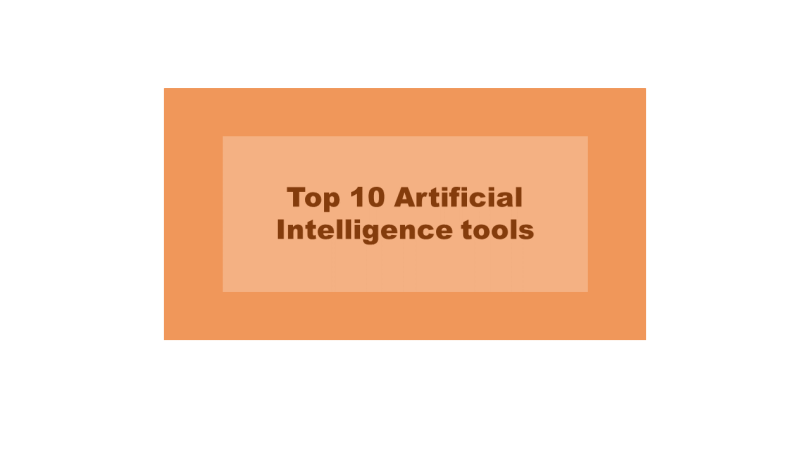Overview:
With the help of cutting-edge technologies, artificial intelligence has transformed the way we live. Every industry has been impacted by AI, which also has a significant impact on all facets of society. For thirty years, artificial intelligence was a stand-alone field of study, but today it has numerous applications in all walks of life. The process of imitating human intellect in robots is known as artificial intelligence, or AL for short. Let’s talk about the ten most popular tools for artificial intelligence.
Scikit Learn:
One of the most popular libraries in the machine learning community is Scikit Learn. Its cross-validation, feature extraction, supervised learning algorithm, and other features make it the preferred library for developers. Yet, it just has one CPU that it uses. Based on SciPy, which also includes Numpy, Matplotlib, Pandas, Sympy, IPython, and SciPy, this library was created. Instead than changing the data, the emphasis is on modelling the data.
TensorFlow:
The most popular deep learning library is TensorFlow. This Google machine learning framework is an open-source Python library. It is one of the top AI development tools that makes numerical computation easier and more accurate for creating predictions in the future.
PyTorch:
PyTorch, another built-in Python utility, comes in second place in the AI tool race. With regard to the type of projects selected, this is comparable to TensorFlow. Nonetheless, PyTorch is a preferable option when expedited development is the top goal. If the project requires bigger, more intricate projects, TensorFlow is no longer an option.
Learn more about: Role of cloud computing in artificial intelligence.
H2O:
This deep learning platform is an open-source artificial intelligence solution for business. It aids in using the data at hand to make wise business decisions. Java is used to write H2O, which also has interfaces for R, Python, Java, Scala, CoffeeScript, and JSON. Predictive modelling, risk analysis, healthcare analytics, and insurance analytics are all fields where the technology is useful.
AutoML:
One of the best artificial intelligence resources currently available to machine learning engineers is AutoML. It uses machine learning techniques to automate the steps needed in formulating a real-world problem. This enables a data scientist to refocus his attention from menial, repetitive chores like modelling to solving the current challenge.
Theano:
Theano is a popular open-source Python deep learning toolbox for data research and neural processing. It is well known for making the process of building complex neural networks simpler by removing the elements of the neural network. It is frequently used to develop and train AI models on graphics processing units (GPUs), and Facebook has utilised it for both the development and deployment of AI applications.
Caffe:
A deep learning framework called Caffe was developed in association with community members. In its architecture, expression, speed, and modularity are emphasised. Strong architectural foundations enable optimization and configuration-defined models without the need for human coding. Moreover, it may switch between the CPU and GPU.
Keras:
One of the greatest AI frameworks is Keras, a Python-based neural network library that is comparable to TensorFlow and CNTK but not designed to be a complete machine learning framework. Keras was created as a human-centric application programming interface (API), not a computer-centric API.
MxNet:
Recurrent neural networks can train on very long sequences thanks to this feature’s ability to swap compute time for memory via “forgetful backdrop.” Developed with the goal of progress. Many helpful tools are available, such as the ability to swiftly build unique layers utilising high-level programming languages.
OpenNN:
OpenNN provides a range of advanced analyses, from those appropriate for a setup for total beginners to those made for more seasoned programmers. There is also Neural Designer, a complex analytics tool. You can use the graphs and tables provided by this tool to better comprehend the data you’ve submitted.
Top AI tools that are going to transform business in 2024
Today, we are witnessing a kind of AI reformation, new tools are being developed over and over again, and AI is being implemented in many applications.
Here is an additional list of the top 10 AI tools for business. These tools are especially helpful for users who do not have much time on their hands, and for those who are not very tech-savvy.
Don’t have a website? No problem.
About it, the website builder powered by Artificial Intelligence allows you to start a business website within a short time on Wix.
Here are the top AI tools for businesses in 2024-2025
Wix: A web design tool that utilizes artificial intelligence and allows users to design and create great business websites.
ChatGPT from OpenAI: A state-of-the-art Text-to-Text transformer model that can be used for generating new human-like texts, perfect for customer service and content generation.
Murf: A text-to-speech converter that will generate realistic and human-like voices for your videos, presentations and more.
Pictory: A tool that uses AI to generate new videos from text or edit text-to-video projects, thus enabling video to be a medium for all.
HitPaw AI Photo Enhancer: Improves the quality of photos by using AI techniques, especially if the photos are intended for marketing and content sharing online.
Fireflies. ai: A service that not only takes and transcribes notes of meetings, but also provides summaries and analysis.
DALL-E 2: An image generation model developed and available through OpenAI that generates images based on textual input.
Jasper: Marketing copywriting tool that assists in the creation of the text for advertisements, blogs and articles.
Grammarly: Grammar-based tool to enhance writing while avoiding any grammatical or spelling mistakes.
Bing Chat: A new AI-based chat tool that delivers better and improved customer experience and assistance.
All these AI tools are built with an aim to increase productivity and creativity; and cater to different requirements in business environments. Thus enabling the companies to sustain themselves in the new world that is rapidly going digital.
Conclusion:
To sum up, computer representations of intelligence are what artificial intelligence (AI) represents. Structures, models, and operational capabilities that can be programmed to solve problems, draw conclusions, process language, etc. are what can be referred to as intelligence. Artificial intelligence is already reaping rewards in a number of industries. To remove biases and inaccuracies, businesses using artificial intelligence should conduct prerelease testing. Models and design should be reliable. Automating all complicated human processes while eradicating biases and errors is the mission of artificial intelligence.






Leave a Comment